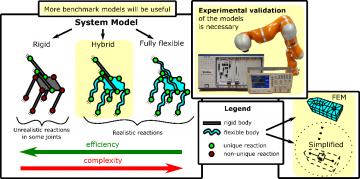Efficient Methods for Hybrid Rigid-Flexible Multibody Systems
The main aim of the project is to develop general-purpose hybrid (rigid-flexible) modeling methods that will enable reliable simulation of redundantly constrained systems while maintaining high computing efficiency.
Formulation and Experimental Validation of Computationally Efficient Methods for Modeling of Hybrid – Rigid-Flexible Multibody Systems with Redundant Constraints–the OPUS-23 grant of National Science Centre of Poland in years 2023-2026 (no. 2022/45/B/ST8/00661)
Multibody systems, i.e., mechanical systems having lots of bodies and degrees of freedom, are commonly used in many areas of modern engineering. Multibody simulation models can be found in diverse areas such as robotics (dynamics of manipulators), automotive (testing of car components and complete vehicles), railroad (e.g., traffic safety), defense (e.g., design of tracked vehicles), etc. Multibody models are also used in control systems.
A simulation model is always a compromise between several objectives; most often, a balance between the accuracy or fidelity of the model and its computational efficiency must be found. This compromise considers many factors, e.g., the availability of the data, the workload needed to build a model, computing capabilities, or the modeling goals. The analysis and simulation of large-scale multibody systems require significant numerical expenses. Simultaneous enforcement of computational efficiency and high-fidelity physical model requirements is difficult to obtain.
The rigid body assumption is frequently adopted in MBS modeling to obtain highly efficient methods. It significantly simplifies the system's physics; nevertheless, multi-rigid-body models can capture essential features of the investigated systems with satisfactory accuracy. There is, however, a broad class of mechanical systems for which the models that assume the rigidity of all the bodies provide erroneous solutions. These systems have redundant constraints (the same degrees of freedom are restrained several times). The redundancy results in the non-uniqueness of calculated joint reaction forces, which may also lead to the non-uniqueness of the simulated motion, making the model useless.
Surprisingly often, problems associated with the redundancy of constraints are ignored in multi-rigid-body simulations–results not embedded in the physics of the system are found. On the other hand, currently available high-fidelity multi-flexible-body models that provide unique and physics-embedded solutions exploit the finite element method and are computationally demanding, making dynamic simulations inefficient.
The main aim of the project is to develop general-purpose hybrid (rigid-flexible) modeling methods that will enable reliable simulation of redundantly constrained systems while maintaining high computing efficiency.
The project will be focused on removing or reducing limitations that diminish the scope of applications of the current methods in the context of the system structure, accuracy, efficiency, and fidelity. The research concentrates on the three groups of issues).
• Development and investigation of efficient hybrid methods for modeling redundantly constrained MBSs that ensure obtaining physically meaningful solutions. Within this objective, it is planned to propose methods dedicated to the conscious use of both rigid bodies and simplified accounting for compliance of parts in terms of equivalent stiffness or—in another variant—in the form of physics‑based penalty factors (in the augmented Lagrangian formulation and similar methods). It should guarantee realistic solutions.
• Development of benchmark problems suitable for testing overconstrained MBSs and examining the numerical properties of formulated modeling methods. One of them should be closely related to the planned experimental setup so that measurements could verify the numerical calculations. The extensive numerical tests will result in both qualitative and quantitative comparison and assessment of various variants of the developed methods.
• Experimental validation of the methods and verification of the simulation results. Within this research objective, it is planned to design and fabricate an experimental setup to conduct research on MBSs with redundant constraints. The test rig should allow for the adjustment of the assembly stresses. Measurements of both static and dynamic loads ought to be available. Using an industrial robot for introducing external loads or kinematic drive is considered to ensure the repeatability of tests carried out.
The following effects of the research are expected:
• developing new numerical tools ready to be implemented in multibody simulation software to conduct automated analyses,
• providing experimental data to validate numerical tools and to get insight into redundancy problems,
• establishing validated benchmark problems for testing MBS models,
• contributing to the state‑of‑the‑art by delivering high‑quality papers,
• promoting research in the field of multibody systems with an emphasis on modeling dynamics of overconstrained systems,
• contributing to the growth of the scientific qualifications of the research team members,
• alleviating existing limitations by providing tools for finding a solution to redundancy-related problems, making it possible to estimate—with acceptable precision—load distribution within an overconstrained multibody system of arbitrary size and topology while maintaining high efficiency.

